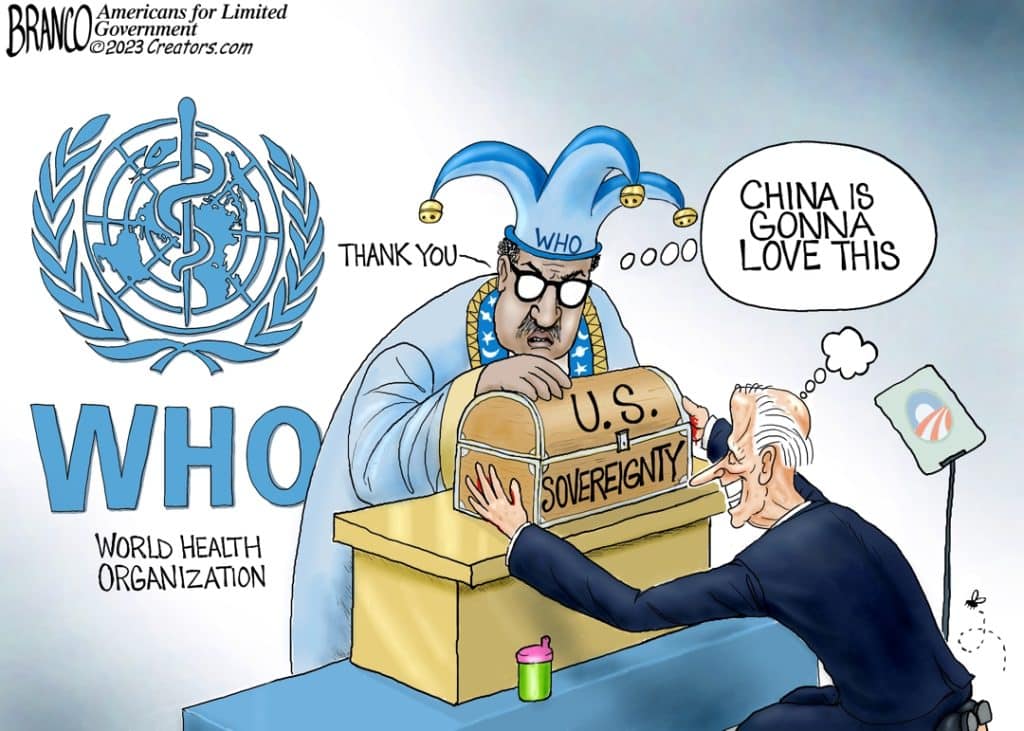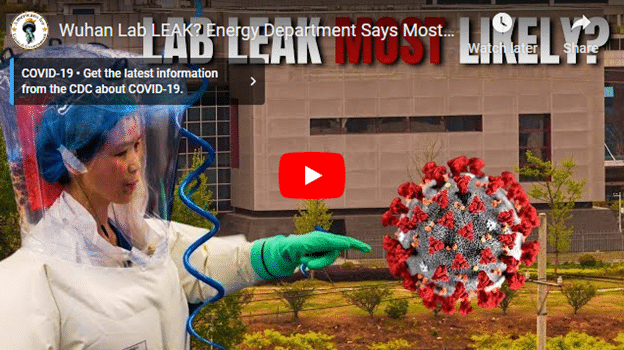Feb. 28, 2023
Permission to republish original opeds and cartoons granted.
Dr. Daszak: Wuhan had ‘over 100 new SARS-related corona viruses, very close to SARS… in the lab.’

By Robert Romano
The National Institutes of Health (NIH) has issued a letter from Lawrence Tabak, Principal Deputy Director of the agency, to U.S. Rep. James Comer (R-Ky.) admitting that under a grant from the National Institute of Allergy and Infectious Diseases (NIAID) to Ecohealth to conduct research of bat-to-human coronavirus transmission mice infected with a created novel coronavirus “became sicker’ than those infected with a normal bat coronavirus.
According to the Oct. 20 letter from Tabak: “The limited experiment described in the final progress report provided by EcoHealth Alliance was testing if spike proteins from naturally occurring bat coronaviruses circulating in China were capable of binding to the human ACE2 receptor in a mouse model. All other aspects of the mice, including the immune system, remained unchanged. In this limited experiment, laboratory mice infected with the SHC014 WIV1 bat coronavirus became sicker than those infected with the WIV1 bat coronavirus. As sometimes occurs in science, this was an unexpected result of the research, as opposed to something that the researchers set out to do. Regardless, the virus being studied under this grant were genetically very distant from SARS-CoV-2…”
Additionally, NIH reported that Ecohealth, by failing to report the increased response of the novel coronavirus, violated the terms of the grant, raising oversight concerns: “EcoHealth failed to report this finding right away, as was required by the terms of the grant. EcoHealth is being notified that they have five days from today to submit to NIH any and all unpublished data from the experiments and work conducted under this award. Additional compliance efforts continue.”
In 2014, a $666,442 grant was awarded by the NIAID to the EcoHealth Alliance and subcontracted to the Wuhan Institute. The grant came atop EcoHealth’s participation in the USAID’s Emerging Pandemic Threats PREDICT $200 million program.
Those grants helped fund a Nov. 2017 study on bat-to-human Covid transmission co-authored by the Director of the Center for Emerging Infectious Diseases at the Wuhan Institute of Virology, Dr. Shi Zheng-li. The study itself confirmed it was “jointly funded by… the National Institutes of Health (NIAID R01AI110964), the USAID Emerging Pandemic Threats (EPT) PREDICT program to PD and ZLS,” among others, according to the study itself.
Fourteen of the study’s authors, including Dr. Shi, are attributed as a part of the “CAS Key Laboratory of Special Pathogens and Biosafety, Center for Emerging Infectious Diseases of Wuhan Institute of Virology, Chinese Academy of Sciences, Wuhan, China,” on the first page of the study.
In addition, the study made use of the Wuhan Institute of Virology, stating in the acknowledgements, “We thank the Center for Instrumental Analysis and Metrology of Wuhan Institute of Virology, CAS, for the assistance in taking confocal microscope pictures”.
In questioning from Sen. Rand Paul (R-Ky.) on May 11, Dr. Anthony Fauci, who heads the National Institute of Allergy and Infectious Diseases stated “[The] NIH has not ever and does not now fund gain-of-function research in the Wuhan Institute of Virology.”
When Paul asked if “Covid 19 could not have occurred through serial passage [a method of creating a virus] in a laboratory,” Dr. Fauci stated, “I do not have any accounting of what the Chinese may have done and I am fully in favor of any further investigation of what went on in China,” and added, “However, I will repeat, the NIH…categorically has not funded gain of function research to be conducted in the Wuhan Institute of Virology.”
Additionally, on July 20, in follow up questioning from Senator Paul, Dr. Fauci said, “I have never lied before the Congress and I do not retract the statement. This paper that you are referring to was judged by qualified staff up and down the chain as not being gain of function.”
Fauci added, “If the point you are making is that the grant that was funded as a subaward from Ecohealth to Wuhan created Sars-Covid 2, that’s where you are getting… I totally resent the lie that you are now propagating, Senator, because if you look at the viruses that were used in the experiments, that were given in the annual reports, that were published in the literature, it is molecularly impossible… to result in Sars-Covid 2.”
“You are implying that what we did was responsible for the deaths of individuals, I totally resent that, and if anybody’s lying here, it is you,” Fauci concluded.
But, to date, no study has identified the origin of the Covid pandemic, whether it came from the lab or from the wild. That is simply unknown. Moreover, the NIH letter to U.S. Rep. Comer only identifies two coronaviruses but Ecohealth has previously said in Dec. 2019 it was working on “over 100 new SARS-related coronaviruses…”
In a Dec. 2019 interview, Dr. Peter Daszak admitted that the research at the Wuhan lab was in fact looking at novel coronaviruses and that the viruses were being manipulated: “we have now found, you know, after 6 or 7 years of doing this, over 100 new SARS-related coronaviruses, very close to SARS… Some of them get into human cells in the lab, some of them can cause SARS disease in humanised mice models and are untreatable with therapeutic monoclonals and you can’t vaccinate against them with a vaccine. So, these are a clear and present danger… I think … corona viruses – you can manipulate them in the lab pretty easily. Spike protein drives a lot of what happen with corona virus, in zoonotic risk. So you can get the sequence, you can build the protein, and we work a lot with Ralph Baric at UNC to do this. Insert into the backbone of another virus and do some work in the lab. So you can get more predictive when you find a sequence. You’ve got this diversity. Now the logical progression for vaccines is, if you are going to develop a vaccine for SARS, people are going to use pandemic SARS, but let’s insert some of these other things and get a better vaccine.”
Read that again. Dr. Daszak, Dr. Shi and the Wuhan lab had “over 100 new SARS-related corona viruses, very close to SARS… in the lab.” The pandemic could have been any one those more than 100 coronaviruses they had in the lab, and Daszak knew it.
According to the grant itself, the funding was for a study in China of “bat-CoV serology against human-wildlife contact and exposure data to quantify risk factors and health impacts of SARSr-CoV spillover” and to “use S protein sequence data, infectious clone technology, in vitro and in vivo infection experiments and analysis of receptor binding to test the hypothesis that % divergence thresholds in S protein sequences predict spillover potential,” according to the grant award from NIH.
Additionally, a May 14 letter to Science magazine co-authored by Dr. David Relman of Stanford University School of Medicine and 17 other doctors says a lab accident remains a “viable” hypothesis alongside a natural event, and urging further review of the subject: “Theories of accidental release from a lab and zoonotic spillover both remain viable. Knowing how COVID-19 emerged is critical for informing global strategies to mitigate the risk of future outbreaks… In November, the Terms of Reference for a China–WHO joint study were released. The information, data, and samples for the study’s first phase were collected and summarized by the Chinese half of the team; the rest of the team built on this analysis. Although there were no findings in clear support of either a natural spillover or a lab accident, the team assessed a zoonotic spillover from an intermediate host as ‘likely to very likely,’ and a laboratory incident as ‘extremely unlikely’. Furthermore, the two theories were not given balanced consideration. Only 4 of the 313 pages of the report and its annexes addressed the possibility of a laboratory accident. Notably, WHO Director-General Tedros Ghebreyesus com-mented that the report’s consideration of evidence supporting a laboratory accident was insufficient and offered to provide additional resources to fully evaluate the possibility. As scientists with relevant expertise, we agree with the WHO director-general, the United States and 13 other countries, and the European Union that greater clarity about the origins of this pandemic is necessary and feasible to achieve. We must take hypotheses about both natural and laboratory spillovers seriously until we have sufficient data.”
Notably, one of the letter’s coauthors is Dr. Ralph Baric of the Department of Epidemiology and Department of Microbiology & Immunology, University of North Carolina at Chapel Hill, one of Dr. Shi’s long-time research collaborators, and one of the world’s foremost experts on novel coronaviruses. In a 2015 study, Baric and Shi were able to combine two separate coronaviruses to create a new one. It appears Baric is worried that such an experiment could have absolutely been the cause of the pandemic, but more investigation is needed.
A June 2021 report from MIT Technology Review’s Rowan Jacobson suggests Daszak was working on “gain of function”: “In 2013, the American virologist Ralph Baric approached Zhengli Shi at a meeting. Baric was a top expert in coronaviruses, with hundreds of papers to his credit, and Shi, along with her team at the Wuhan Institute of Virology, had been discovering them by the fistful in bat caves… Baric had developed a way around that problem—a technique for ‘reverse genetics’ in coronaviruses. Not only did it allow him to bring an actual virus to life from its genetic code, but he could mix and match parts of multiple viruses. He wanted to take the “spike” gene from SHC014 and move it into a genetic copy of the SARS virus he already had in his lab. The spike molecule is what lets a coronavirus open a cell and get inside it. The resulting chimera would demonstrate whether the spike of SHC014 would attach to human cells… While Baric’s study was in progress, the National Institutes of Health announced that it would temporarily halt funding for ‘gain of function’ research—experiments that make already dangerous viruses more virulent or transmissible—on SARS, MERS (which is also caused by a coronavirus), and influenza until the safety of such research could be assessed. The announcement brought Baric’s work to a standstill.”
Here, Jacobson is referring to NIH’s 2014 moratorium on “gain of function” research. But it never impacted the Wuhan subcontract. The original grant came in May 2014, and the moratorium on no new funding for the research came in Oct. 2014. In the moratorium, the existing funding was merely “encouraged” to “voluntarily” pause the research: “we will encourage the currently-funded USG and non-USG funded research community to join in adopting a voluntary pause on research that meets the stated definition. The deliberative process that will ensue during the period of the research pause will explicitly evaluate the risks and potential benefits of gain-of-function research with potential pandemic pathogens.”
Now, whether Ecohealth and the Wuhan lab were doing gain of function research or not, and whether Fauci was truthful to Congress or not obscures the more important questions surrounding Daszak's research. Daszak’s admission in Dec. 2019 that he was working on “over 100 new SARS-related coronaviruses, very close to SARS… in the lab” raises the troubling possibility that indeed the Covid pandemic could have originated at the Wuhan lab.
Naturally, the NIH letter only talks about one novel coronavirus, which it says couldn't have been the progenitor of the Covid pandemic: "the virus being studied under this grant were genetically very distant from SARS-CoV-2…" But what about the other 99 "new SARS-related coronaviruses, very close to SARS" that Wuhan was keeping "in the lab"?
That is why U.S. Rep. Bill Posey (R-Fla.) is proposing H.R. 834, which would create a bipartisan commission to look at the origins of the virus.
In a Washington Examiner oped on Feb. 26, Posey revealed that rather than conducting an investigation of Wuhan lab, world health officials instead depended on Dr. Peter Daszak of EcoHealthto lead the crucial inquiries into whether his own experiments might have been the cause of the pandemic.
As Posey noted, the Daszak-led investigations remarkably went on to give the Wuhan lab a clean bill of health: “Ironically, the Lancet chose Daszak to lead its investigation into the origins of COVID-19, including its possible origins at Wuhan — a theory Daszak has repeatedly called a ‘conspiracy theory.’ WHO also included Daszak as a key member of its investigation team. Unsurprisingly, the WHO investigation team concluded on Feb. 8, after a brief visit to the Wuhan Institute, that it was unlikely the virus leaked from a lab, and this possibility needed no further investigation.”
Now, with 5.3 million Covid deaths worldwide and NIH’s admission that Ecohealth was violating the terms of the grant by not turning over all data, if nothing else, Congress should be hauling Daszak in for questioning. Nobody other than Dr. Shi might know more about the potential Wuhan lab origin of the virus. We won’t know unless and until it is thoroughly investigated, but right now Congress appears to be in no rush to get started.
Robert Romano is the Vice President of Public Policy at Americans for Limited Government.
Cartoon: No Joke
By A.F. Branco

Click here for a higher level resolution version.
To view online: https://dailytorch.com/2023/02/cartoon-no-joke/
Video: Wuhan Lab LEAK? Energy Department Says Most Likely TRUE

To view online: https://www.youtube.com/watch?v=-m5ancKWOWU

